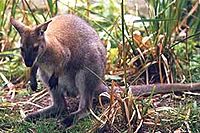Macropus facts for kids
Quick facts for kids Macropus |
|
|---|---|
 |
|
| Red-necked Wallaby | |
| Scientific classification | |
| Kingdom: | |
| Phylum: | |
| Class: | |
| Infraclass: | |
| Order: | |
| Suborder: | |
| Family: | |
| Genus: |
Macropus
Shaw, 1790
|
| Species | |
|
14 species, see text. |
|
Macropus is a group of amazing animals that belong to the marsupial family. These animals are special because their babies are born very tiny and then grow inside a pouch on their mother's belly. The Macropus family includes all the big kangaroos, wallaroos, and several kinds of wallaby. There are 14 different types, or species, in this group.
Contents
What is a Macropus?
The word Macropus comes from Greek words meaning "large foot." This name fits perfectly because these animals are known for their big, strong back feet. They use these feet to hop around. They also have powerful tails that help them balance.
Where Do Macropus Live?
Most Macropus species live in Australia. Some can also be found in New Guinea and nearby islands. They live in many different places, from dry grasslands to forests. Each type of Macropus has a favorite kind of home.
How Macropus Move and Eat
Macropus animals are famous for their hopping. They can travel very fast and cover long distances with each jump. Their strong legs act like springs. They are mostly active during the cooler parts of the day, like dawn and dusk.
These animals are herbivores, which means they eat plants. Their diet mainly includes grasses, leaves, and sometimes fruits. They have special teeth that help them grind up tough plant material.
Types of Macropus
The Macropus genus is divided into smaller groups called subgenera. These groups help scientists organize the different species. Let's look at some of the cool animals in each group.
The Notamacropus Group
This group mainly includes many types of wallabies. Wallabies are like smaller versions of kangaroos.
- Agile Wallaby (Macropus agilis): These wallabies are very quick and often found near water.
- Black-striped Wallaby (Macropus dorsalis): You can spot these by the dark stripe down their back.
- Tammar Wallaby (Macropus eugenii): These are smaller wallabies that are good at living in different habitats.
- Toolache Wallaby (Macropus greyii): Sadly, this wallaby is now extinct. It means they are no longer alive anywhere in the world.
- Western Brush Wallaby (Macropus irma): These wallabies live in the western parts of Australia.
- Parma Wallaby (Macropus parma): This species was thought to be extinct for 100 years, but then it was rediscovered!
- Pretty-faced Wallaby (Macropus parryi): They are known for their distinctive face markings.
- Red-necked Wallaby (Macropus rufogriseus): These wallabies have reddish fur on their neck and shoulders.
The Osphranter Group
This group includes some wallaroos and the famous Red Kangaroo. Wallaroos are usually bigger than wallabies but smaller than the largest kangaroos.
- Antilopine Kangaroo (Macropus antilopinus): These kangaroos are found in northern Australia.
- Woodward's Wallaroo (Macropus bernadus): A type of wallaroo found in rocky areas.
- Eastern Wallaroo (Macropus robustus): Also known as the Common Wallaroo, they are very sturdy.
- Red Kangaroo (Macropus rufus): This is the largest marsupial in the world and can grow very big!
The Macropus Group
This group contains the two largest and most well-known kangaroo species.
- Western Grey Kangaroo (Macropus fuliginosus): These kangaroos are common in southern Australia.
- Eastern Grey Kangaroo (Macropus giganteus): This is another very large kangaroo, often seen in eastern Australia.
See also
 In Spanish: Macropus para niños
In Spanish: Macropus para niños

